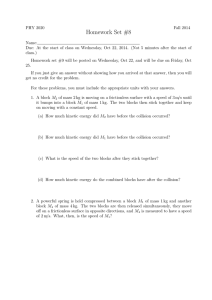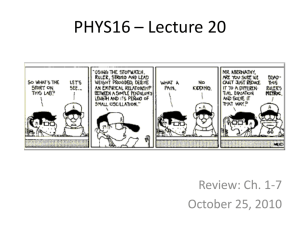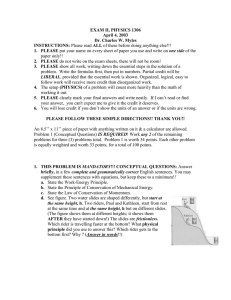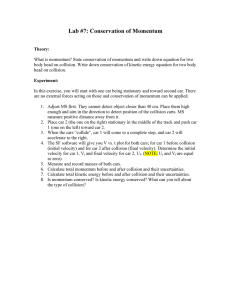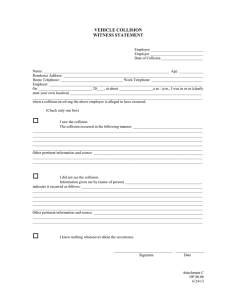EXAM III, PHYSICS 1306 July 31, 2002 Dr. Charles W. Myles INSTRUCTIONS:
advertisement
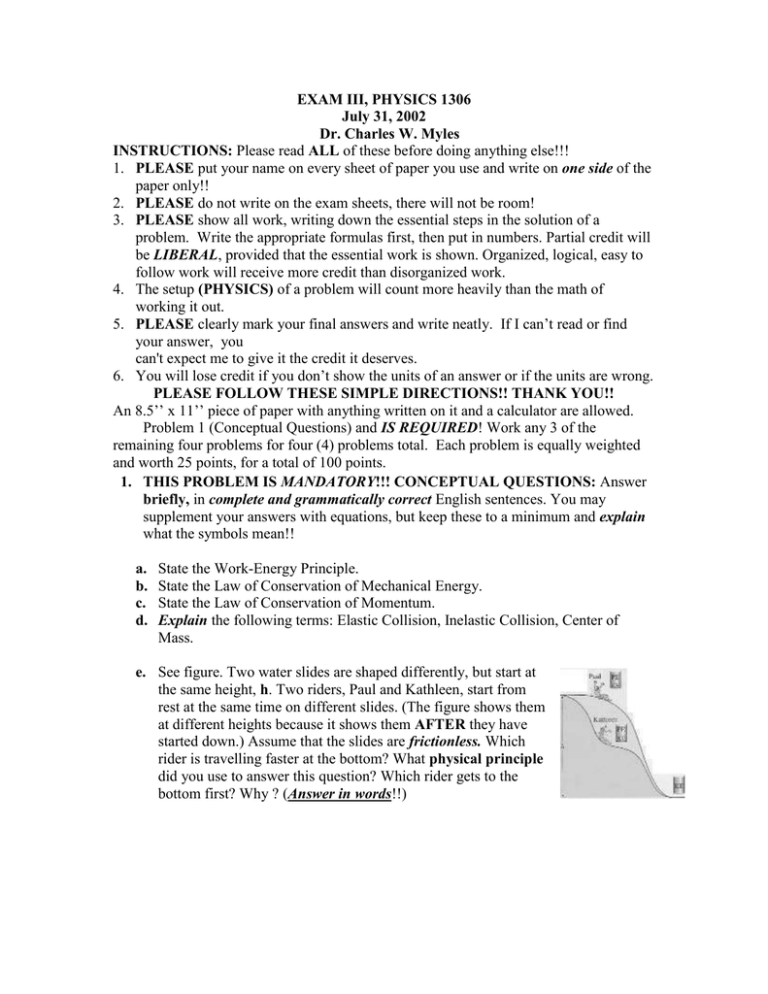
EXAM III, PHYSICS 1306 July 31, 2002 Dr. Charles W. Myles INSTRUCTIONS: Please read ALL of these before doing anything else!!! 1. PLEASE put your name on every sheet of paper you use and write on one side of the paper only!! 2. PLEASE do not write on the exam sheets, there will not be room! 3. PLEASE show all work, writing down the essential steps in the solution of a problem. Write the appropriate formulas first, then put in numbers. Partial credit will be LIBERAL, provided that the essential work is shown. Organized, logical, easy to follow work will receive more credit than disorganized work. 4. The setup (PHYSICS) of a problem will count more heavily than the math of working it out. 5. PLEASE clearly mark your final answers and write neatly. If I can’t read or find your answer, you can't expect me to give it the credit it deserves. 6. You will lose credit if you don’t show the units of an answer or if the units are wrong. PLEASE FOLLOW THESE SIMPLE DIRECTIONS!! THANK YOU!! An 8.5’’ x 11’’ piece of paper with anything written on it and a calculator are allowed. Problem 1 (Conceptual Questions) and IS REQUIRED! Work any 3 of the remaining four problems for four (4) problems total. Each problem is equally weighted and worth 25 points, for a total of 100 points. 1. THIS PROBLEM IS MANDATORY!!! CONCEPTUAL QUESTIONS: Answer briefly, in complete and grammatically correct English sentences. You may supplement your answers with equations, but keep these to a minimum and explain what the symbols mean!! a. b. c. d. State the Work-Energy Principle. State the Law of Conservation of Mechanical Energy. State the Law of Conservation of Momentum. Explain the following terms: Elastic Collision, Inelastic Collision, Center of Mass. e. See figure. Two water slides are shaped differently, but start at the same height, h. Two riders, Paul and Kathleen, start from rest at the same time on different slides. (The figure shows them at different heights because it shows them AFTER they have started down.) Assume that the slides are frictionless. Which rider is travelling faster at the bottom? What physical principle did you use to answer this question? Which rider gets to the bottom first? Why ? (Answer in words!!) NOTE: WORK ANY THREE (3) OF PROBLEMS 2., 3., 4., or 5.!!!!! 2. Two bumper cars in an amusement park undergo an elastic collision as one approaches the other from the rear. Their masses are m1 = 450 kg and m2 = 550 kg. Their initial velocities are both in the same direction, as in fig. a). The initial velocity of m1 is v1 = 4.5 m/s and that of m2 is v2 = 3.7 m/s. After the collision, their velocities v1´ & v2´ are both still in the same direction, as in fig. b). a. What is the total momentum p1 + p2 of the two cars before the collision? What is the total kinetic energy KE1 + KE2 of the two cars before the collision? b. What is the total momentum p1´+ p2´ of the two cars after the collision? What is the total kinetic energy KE1´ + KE2´of the two cars after the collision? What physical principles did you use to find this result? c. Calculate the velocities v1´ & v2´ of the cars after the collision. d. What impulse was delivered to m2 by m1? (Stated another way, what was the change in momentum of m2 due to the collision?) e. If the collision time was t = 2 x 10-2 s, use the results of part d to compute the average force exerted by m1 on m2. 3. See figure. Use energy methods to solve this problem!!! You will receive NO credit for using force methods! You don’t need to resolve forces into components to solve this!! A block, mass m = 35 kg, slides across a frictionless horizontal surface and up on to an inclined plane. The incline angle is 37with respect to the horizontal. At the bottom, the mass has a velocity of v = 12 m/s. The mass moves up the plane and stops at a height H above the horizontal surface. a. What is the kinetic energy of the block at the bottom? b. If the incline is frictionless, what is the gravitational potential energy of the mass when it has stopped? At what height H above the horizontal surface does it stop? c. If the incline is frictionless, at what height y above the horizontal surface does the mass have a velocity of 8 m/s? d. Parts b & c assume no friction. Suppose you test this assumption experimentally. The height H that you measure for the block after it has stopped at the top of the incline is 6 m. This is less than the height you (should have) computed in part b. This means that friction cannot be neglected. In this case, how much work is done by friction? e. BONUS!! 5 EXTRA POINTS!! In part d, what is the force due to friction between the block and the incline? NOTE: WORK ANY THREE (3) OF PROBLEMS 2., 3., 4., or 5.!!!!! 4. See figure. A railroad engine, mass M = 60,000 kg, traveling at a speed of 30 m/s strikes a car, mass m = 8,000 kg, which is at initially at rest because it is stuck in the crossing (the people in the car have run away from it!). After the collision, the railroad engine and the car STICK TOGETHER and move off down the tracks. Before Collision After Collision a. What were the initial momentum and kinetic energy of the engine? b. What was the momentum of the engine-car combination as they moved away from the collision? What was their speed immediately after the collision? What physical principle did you use to find these? c. What was kinetic energy of the engine-car combination just immediately after the collision? Was kinetic energy conserved? Was momentum conserved? Explain (using brief, complete, grammatically correct English sentences!). d. What impulse was delivered to the car by the engine? (Stated another way, what was the change in momentum of the car due to the collision?) If the collision time was t = 3 x 10-2 s, what was the average force exerted by the engine on the car? e. After the collision, the engine-car combination skids until it stops a distance d = 50 m away from the collision point. Assuming that work by the frictional force between the engine-car combination and the track is what causes them to stop, how much work is done by friction in this process? 5. See figure. A toy gun uses an ideal, stiff spring to shoot balls. The spring constant is k = 250 N/m. Neglect the ball’s gravitational potential energy in parts a., b., and c. Before shooting After shooting a. When the gun is cocked, the spring is compressed a distance x = 0.15 m. What is the elastic potential energy of the spring when the gun is cocked? b. If the gun shoots a ball of mass m = 0.25 kg, what is the kinetic energy of the ball just after it leaves the barrel? What physical principle did you use to find this result? c. What is the speed of the ball just after it leaves the barrel? d. Assume that, after leaving the barrel, the ball is initially travelling horizontally at the speed computed in part c. If it is fired from a height h = 2 m above the ground (and taking y = 0 as the ground level), what is its gravitational potential energy at that point? What is its total mechanical energy at that point? e. As the ball travels past the initial point discussed in part d., it falls to the Earth, some horizontal distance away. What is the kinetic energy of the ball just before it hits the ground? What is its speed at that same point?
